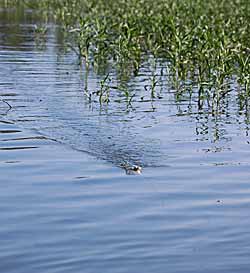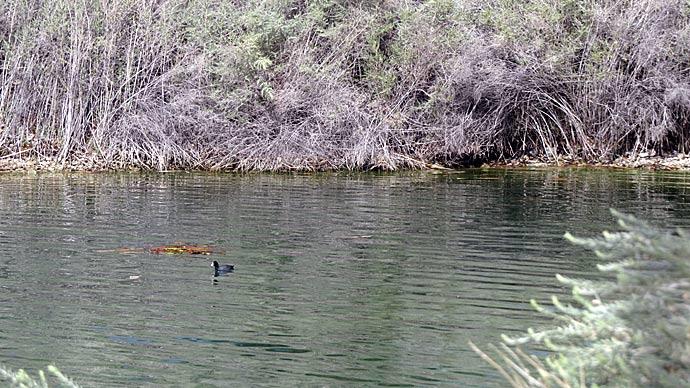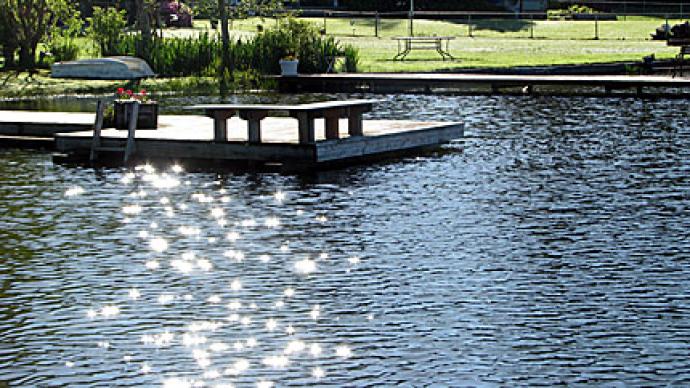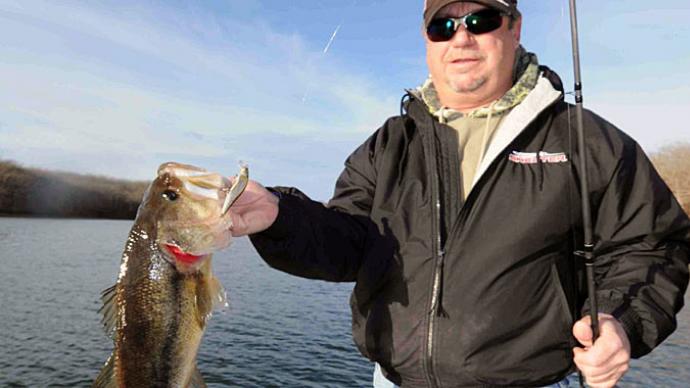
Oxygen, alkalinity, pH, hardness, minerals, metals. Acidic, basic, soft. If these terms sound a bit foreign, they shouldn't.
Lake specialists and fisheries biologists always want to know the pH reading of the water. Why?
How much oxygen do our fish need? Where does oxygen, in water, come from? Should we fertilize our pond? Biologists are forever asking for the total alkalinity of your water.
There must be a reason. But, unless you aced chemistry in school, this stuff doesn't make much sense to a casual pondmeister or angler. That's too bad. A pond or lake owner can never maximize on the recreational potential and manage for peak fish production until he (she) develops a fundamental grasp of the most crucial element in a pond - its water.
So, welcome to pond and lake water chemistry class.
Water is an amazing substance. Scientists call the wet stuff the "universal solvent." Dissolving everything it possibly can, H20 is the lifeblood of most every living thing on earth.
Going without food for a few days might be a positive for some of us. But going without water for a few days could be hazardous to your health, even potentially deadly.
Lake water is alive, moving, adjusting, coming and going, all based on the cornerstones of earth science and biology. Biology of water depends on its chemistry. Different plants and animals grow in different water with different chemistry.
Take the common species of algae, chara, for example. Aptly nicknamed "skunkgrass" because of its musty odor, this native plant has an outer coating, crunchy to the touch. Tug a wad of chara to shore, lay it on the beach for a day, then go look.
The lively lime green color quickly fades to a white powdery substance. Chara is coated with calcium, gleaned from pond water as the plant grows. Chara grows in hard water, full of calcium, or limestone. You won't see chara in soft, acidic water.
pH is the measure of free hydrogen ions dissolved in water. A pH of 7 is neutral. Less than 7 is a measure of "acidic." More than 7 is "basic." pH is logarithmic. A pH of 6 is 10 times more acidic than 7. Which means a pH of 5 is ten times more acidic than 6, but 100 times more acidic than 7. See the pattern?
As you scratch your head, you might be asking why pH is important.
Recreational fishing lakes and ponds need a pH between 6.2 and 9.0 to be most productive for fish, for healthy plant life and to have the ability to adjust to nature's variables. Rain, dirt, organic matter readily influence pH ratings.
"Acidic" means your pond has free hydrogen ions, lacking the ability to "buffer." Which also means your water isn't dissolving many minerals from surrounding soils. Batteries and tree leaves have acid. Vinegar is a mild acid. Rolaids, baking soda and lime- stone are "bases," which serve to neutralize acids, and vice versa.
So, if your water has plenty of dissolved minerals, the resulting hardness and alkalinity have a calming effect on the acids which make their way from the nature's watershed.
Alkalinity is a measure of bases, usually carbonates or bicarbonates dissolved in your water. Carbonates are attached to calcium. Calcium is a fundamental building block for plankton. No calcium, no plankton. No plankton, no bugs. No bugs, no tiny fish. No tiny fish, no bigger fish.
You can fertilize until you are green in the face, but if alkalinity is too low, your lake won't be green with phytoplankton. Biologists who evaluate your water will say the total alkalinity needs to be at least 20 parts per million, in order to successfully fertilize in spring.
"Hardness" is a term to quantify dissolved minerals and metals. Could be calcium, maybe magnesium or iron. This stuff comes from surrounding soils, or from the lime truck.
Here's where biologists start scratching their heads. How does pH, hardness, alkalinity, and calcium and metals, and all this chemistry stuff work together (or against each other) to affect a lake?
pH is a shifty little measurement of daily moving changing, rising, falling amounts of hydrogen. pH on a warm, sunny summer morning may be 8.2. But, later that afternoon, in a well-fertilized pond, pH could easily drop to 6.5, while alkalinity and hardness stay the same. What gives?
Biology directly affects chemistry of pH. Living phytoplankton photosynthesizes during sunlight hours. When the sun disappears, phytoplankton respires. During photosynthesis, phytoplankton and plants consume carbon dioxide, then produce oxygen. During respiration, the reverse happens. Carbon dioxide reacts with water, and a chemical reaction occurs which produces carbonic acid, which lowers pH.
Don't let all this scientific lingo disrupt the serenity and joy you get from your pond. Just keep in mind that if the water ain't right, the living pond won't be right. So, what to do?
Monitor your water chemistry, and try to understand the basics.
The easiest parameter to check is oxygen. Most warm water fish need a minimum of 3 parts per million (ppm) dissolved oxygen to survive. Key word? Survive.
Water's saturation point for oxygen depends on temperature. Warmer water has less affinity for oxygen than cooler water. That's why oxygen or water chemistry related fish-kills occur during the warmest months. Eight ppm is best.
So, prudent pond managers check their water chemistry several times yearly, and compare the findings each time they check.
Oxygen changes daily, maybe hourly, maybe every minute, because of consumption and creation of that critical element. Fish must have oxygen, filtered from water through their gills. Plants "create" oxygen during daylight hours, but use oxygen when there's no sun. Investigate different methods to monitor your water's chemistry, and pick out the best method. There are various kinds of meters and kits out there to check just about anything you want. Several Pond Boss advertisers sell user-friendly water-testing equipment - Aquatic Eco-Systems, The Pond Guy, Stoney Creek and Myron L Company.
Check oxygen, pH, alkalinity, for sure. But, you may want to know the levels of nitrogen, phosphorus, total hardness, too.
Dana Wregglesworth, national sales manager for the Myron L Company said, "Handheld water quality instruments are available that provide an on site, accurate, reliable and simple to use means to ensure the continued health of any fishing pond. Buy one that features these general characteristics and you're way ahead of the game."
Wregglesworth points out that fish need quality water to survive and thrive.
"Quality water has practically no pollutants, is consistently high in dissolved oxygen, and doesn't have excessive organic matter or suspended silt," he said.
You've invested big money and time in your pond and its health. When water quality deteriorates, the results can be devastating. A few hundred dollars devoted to water chemistry analysis equipment could be the difference between enjoying your 5-year-old pond, or restocking because of a massive fish-kill.
Do this: Have your water chemistry checked by a lab. Have the results interpreted by a qualified biologist. The science guy will look for "weak spots" in your water. Older ponds, ponds with soft water, and ponds pushing the limits of fish carrying capacity absolutely need consistent water chemistry checks.
If your pond meets any one of these qualifications, take a close look at buying water chemistry equipment.
After all, a little science lesson never hurt anyone. Actually, it's fun. Besides, water chemistry changes could be the difference that keeps your pond growing, thriving and moving.
Reprinted with permission from Pond Boss Magazine



